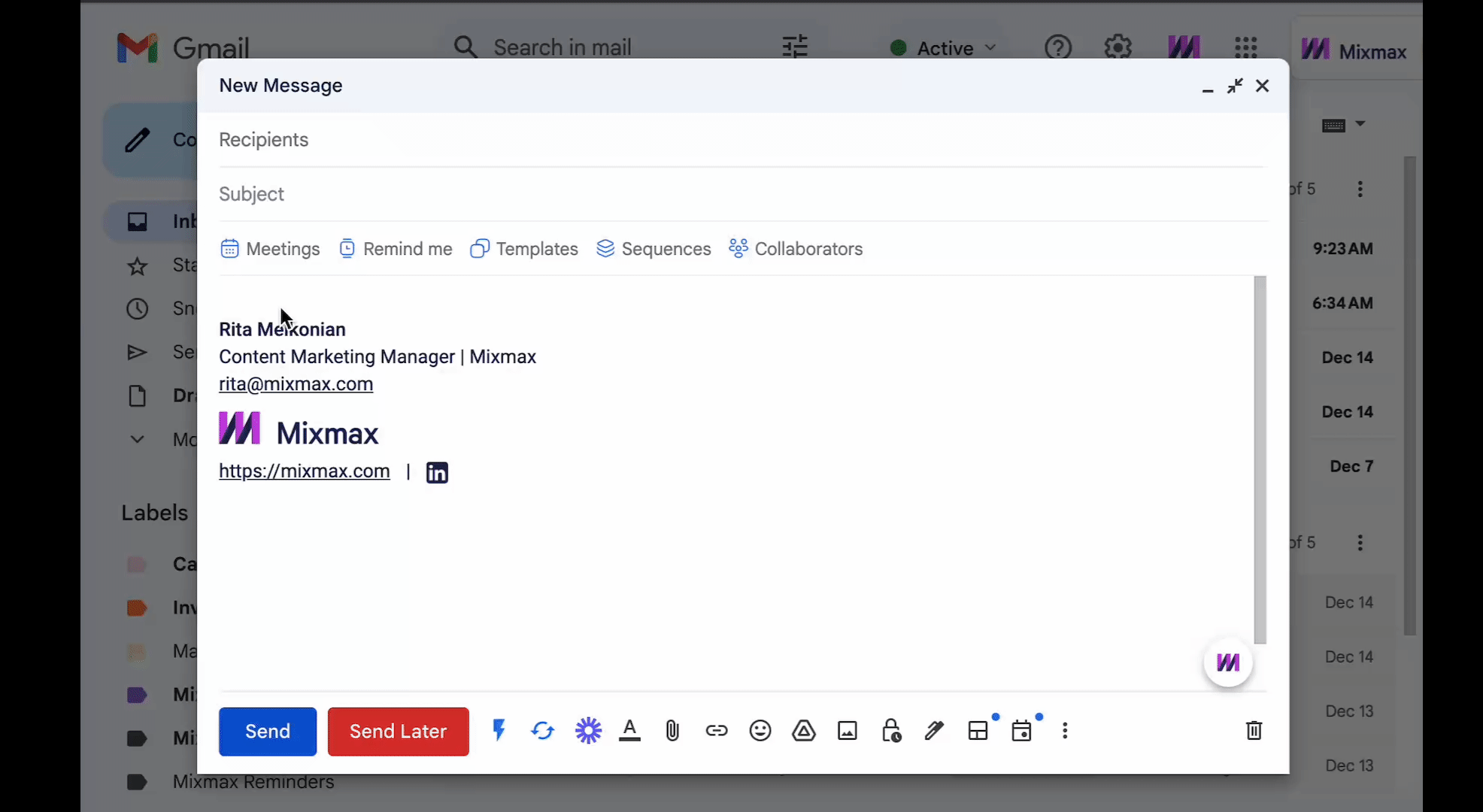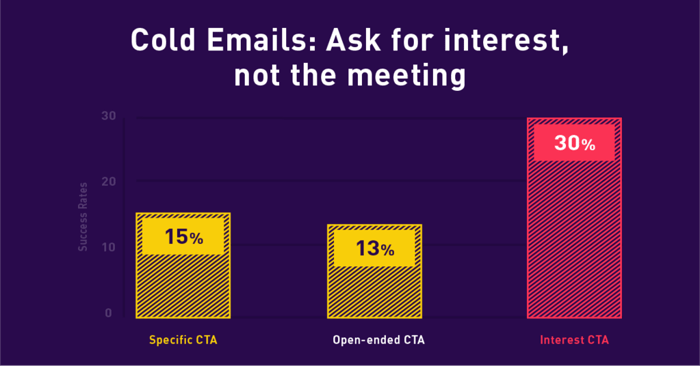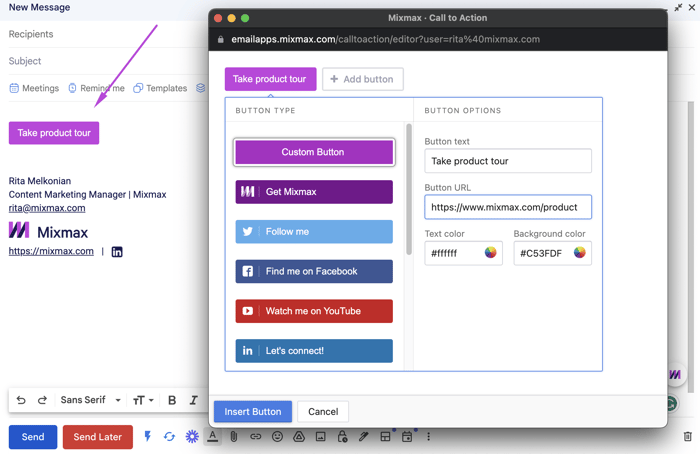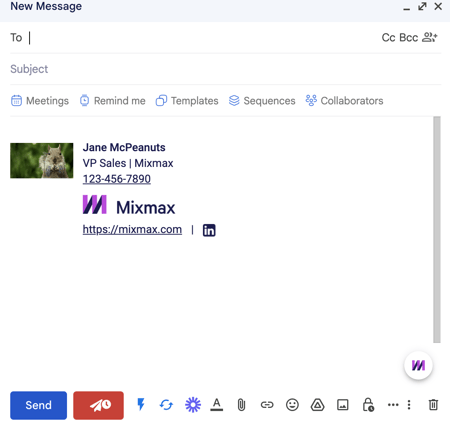
Picture this...
It’s Thursday afternoon, you’re on your fourth coffee, “Mr. Brightside” by The Killers is blasting through your headphones, and last night’s pizza is waiting in the fridge with your name on it.
Life is good.
You’re about ready to hit Send on a batch of sales emails you’ve prepared for your prospects. You’re feeling confident about it.
You scroll through them one last time, making sure everything checks out.
Then your song ends, and at that very moment, your eyes fixate on your email closing lines.
You re-read them. Three times. Then your confidence wavers. Your email sign off sounds generic. Outdated.
“Is… is this why my email response rate sucks lately?” you think to yourself, horrified.
As a sales rep, there’s nothing more frustrating than spending time drafting emails for prospects only to be met with radio silence.
And lately, that’s all you’ve been getting. You’re ready for a change.
If you want to know how to end a sales email to boost your response rate, you’ve come to the right place.
Let’s take a look.
You know how important it is to get email subject lines just right. It's the very first thing recipients see in their inbox.
If the subject line doesn’t entice them to open the email, you've wasted all the effort you put into writing it.
You also know how important the sales email opening line is as it's the second thing recipients see after opening it. Sometimes parts of it even appear in the preview text.
But what about the end of the sales email? Is it worth perfecting?
The answer is HECK YES.
And here’s why.
We’ve all heard people say “first impressions count.” Sure they do. Of course they do.
But what about the underdog? The last impression?
That counts too, especially in a sales email.
If anything, it might count even more because some people skip to the bottom to see what the sender wants and who they are.
So the end of your sales email might be just the thing to convince them to take action, leading to an increase in response rate.
The goal of your sales email is to engage your prospect. You want to pique their interest. You want them to want to reply.
To achieve this, you should end your email with relevant information. You can also include a call to action (CTA) that prompts the recipient to take action.
If you’re using a sales engagement platform connected to your inbox, you can easily add interactive widgets to your emails. These widgets include polls and surveys (handy for people who don’t want to write a response), GIFs, and link previews that help with visualization.

Mixmax Polls enable prospects and customers to reply with one click.
The less ambiguous you are with your email closing lines, the more likely it is that your prospect will want to reply.
Show a clear path to action. You can achieve this with interactive widgets (as shown earlier) or a one-liner that will get them to confirm they're interested.
Make it obvious and easy to respond to.
Asking for a meeting right off the bat just doesn’t cut it anymore (did it ever?). According to Gong, the Interest CTA is the highest-performing call to action for cold emails.
 Interest CTAs perform 30% better than specific or open-ended CTAs. Stats & image by Gong.
Interest CTAs perform 30% better than specific or open-ended CTAs. Stats & image by Gong.
In other words, it’s better to try to sell the conversation, not the meeting.
If your sales email sign off doesn’t show who you are, your prospect is going to hit that delete button faster than you can say pipeline.
The recipient needs to know who is contacting them so they don’t classify you as spam. And the more credible you look, the more open they will be to talking to you.
Image this – would you respond to a cold email signed J. McPeanuts, VP of Peanuts Inc.? Actually, that might be an enjoyable chat. But you get the point.
Providing contact information is important when considering how to end a sales email to boost replies.
Sure, everyone knows they can click Reply to answer an email. But showing this contact info will make it even easier for your prospects to reach you or learn more about you:
Plus it boosts your credibility factor, which gets you one step closer to the edge and I’m about to break getting a reply.
You know why it’s important to perfect your sales email sign off; now it’s time to execute.
Your sales email closing line can take many forms, but usually what works best is a combination of several of the elements listed below.
And if neither of those works the first time around, don’t hesitate to send a follow-up email (or three).
Watch the full webinar recording with Jason Bay and Jack Wauson on cold email tactics that boost replies
Our sales engagement platform can automate this process for you with multichannel email sequences that can be set up across multiple touchpoints in Salesforce or Gmail.
Ok, on to the actual how-to.
If you were meeting with your prospects in real life, you wouldn’t boast about yourself and your achievements the entire time, right?
The same rule applies when emailing. End the email with a question they’ll be compelled to answer instead of telling them how much you’d LOVE to book a quick meeting.
Write it in a way that will make them understand what they’ll be missing out on if they decide to ignore you.
Here’s one example we like to use (with more to follow):
Would eliminating manual & repetitive work to boost your team’s productivity be something that would help you reach your Q2 target this year?
| Related post: 16 Non-Obvious Cold Email Tactics to Increase Reply Rates |
A question that captures interest is a great call to action, but you can also include a branded CTA button that might be more visually appealing to your recipients.
Don’t use generic CTAs like Learn More.
We’re talking impactful buttons that will provoke them to click. Think more along the lines of See what {Client} has to say.

Tip: Mixmax has an integrated CTA button functionality that allows you to add custom buttons to your email (as shown above).
Signing an email with Best + First Name will make you seem unprofessional and spammy. It’s just not the right tactic for cold emails.
The best way to gain your prospects’ trust is to create a corporate signature that contains relevant information.
Things you can include are:

Postscripts are seriously underrated. They’re a fantastic way to capture your recipient’s attention just when they thought the email had nothing to offer.
According to Siegfried Vogele, author of Handbook of Direct Mail: The Dialogue Method of Direct Communication, over 90% of readers read the PS before the letter.
Some of this is attributed to the fact that people like completing tasks, and by jumping to the end of the email to read the postscript, they feel like they have accomplished the task of reading and understanding the purpose of the email.
Writing a personalized P.S. section is what will make your email stand out from the rest. It’s what will make prospects realize that you’re not just rehashing an old template for the thousandth time.
Here’s an example of a P.S. section you can include at the end of a sales email that might get your prospects to hit that Reply button.
P.S. Saw the [topic] meme you posted on LinkedIn last week and literally laughed out loud.
OR
P.S. [Similar Company] was also struggling with [pain point] until they switched to [Your Company]. You can read all about it here :)
Nothing looks more sketchy than an email filled with spelling and grammar mistakes.
This doesn’t only apply to the end of a sales email, but we thought it’s worth mentioning anyway. If you don’t have an email enhancer such as Lavender or Grammarly, we suggest you get on that. Like now.
A good way to understand how to end a sales email is to learn how not to end a sales email. Some of the things that used to work in the past just don’t work anymore, and it’s important to keep up with sales email trends as they evolve.
Here are some things to avoid.
If you’re sending a cold email, chances are your prospect has no idea who you are. And chances are they don’t want to meet with you.
Would you agree to go on a date with a stranger you met five seconds ago?
Cold emailing is all about introducing yourself and asking the right questions to get your prospect to consider going on a date with you (we don’t mean this literally, obviously!).
So take it easy. Keep the “let’s book a quick meeting this week to discuss” for your next email.
Let’s keep the dating analogy going.
If you meet someone for the first time, are you going to talk about yourself non-stop? No, because that’s lame, right?
The same goes for your sales email sign off. Make sure you focus on their needs and reiterate how you can help them with their pain points.
Don’t overuse “I” and “we.” Instead, use “you” and “your.”
If you're too pushy or aggressive in your email closing lines, you're going to push your prospects over the edge. In other words, your email will end up in their trash bin, only to be permanently deleted 30 days later.
Avoid using words like “you have to” or “you should” or “book now.” These can easily annoy or offend your recipient, which definitely won’t get you a reply.
Now that we’ve established a strategy for your sales email closing lines, let’s dive into some plug-and-play examples that will help you boost your response rate.
1. Are you actively trying to improve [prospect’s business goal]?
2. I have a presentation on [prospect’s needs]. Want me to send it over?
3. Open to exploring new strategies for [specific business process]?
4. Interested in learning how [Competitor] is achieving [positive outcome]?
5. Is fixing [problem] top of mind for you right now?
6. Game to explore how [company] can help with this?
7. Ever tried [type of solution] before?
8. Would it help your team if they could [outcome]?
9. We’ve helped companies like [Similar Client] achieve their goals. Want us to help you achieve yours?
10. Would you be interested in us sharing some of our insights with you?
11. I recently read an article about [industry trend] and thought it might interest you. Can I share the link?
12. Interested in discovering how [industry leader] successfully navigated [challenge] using [your solution]?
13. How confident are you in achieving [specific goal] with your current approach?
14. Mind if I send over a report on [relevant topic with stats]?
15. Ever considered implementing [type of solution] before?
16. Open to receiving some valuable insights from us?
17. Could your team benefit from the ability to [outcome]?
*Several of these are borrowed from the insightful Hans Dekker from Lyne.ai.
18. P.S. Are you planning on attending [important event]? I’m psyched for it!
19. P.S. I noticed you're into [common interest]. I’m all ears if you want to chat about it!
20. P.S. How would it feel to help your team achieve [goal] in half the time?
14. P.S. Here’s what changed for the better when [Popular Company] decided to take a leap of faith with [Company].
15. P.S. Just leaving this infographic on [topic] here in case you’re interested :)
21. P.S. Just found this podcast episode on [relevant topic] that resonated with me. Thought you might find it interesting too.
22. P.S. Thought this blog on [topic] might be interesting to you!
23. P.S. How much time do you spend on [task] every day?
24. P.S. Wondering if you've had a chance to explore the latest updates on [industry news].
25. P.S. Heard about [event] happening next month. Would love to connect if you'll be there!
26. P.S. Found an interesting article on [topic] that aligns with our recent discussion.
27. P.S. We just published a success story about [Client Name] and thought of how similar their situation was to yours.
28. I appreciate the time, [Prospect Name]. We look forward to working with you.
29. Just in case you have questions, [Prospect Name], I attached a few resources below. Happy to help if you can’t find your answer.
30. Thanks again, [Prospect Name]. I know how hectic your schedule is and I’m grateful you made time for this.
Every part of a sales email is important, but the end of the email is ultimately what will convince your recipient either to reply or ignore you. The key is adding value to your email sign off with personalization and relevance.
Check out our piece on cold email strategies for tips on how to 10x your response rate.

Rita Melkonian is the content marketing manager @ Mixmax with 8+ years of experience in the world of SaaS and automation technology. In her free time, she obsesses over interior design and eats her way through different continents with her husband & daughter (whose fave word is "no").
.png?width=450&height=250&name=Episode%20Graphic%20(1).png)
